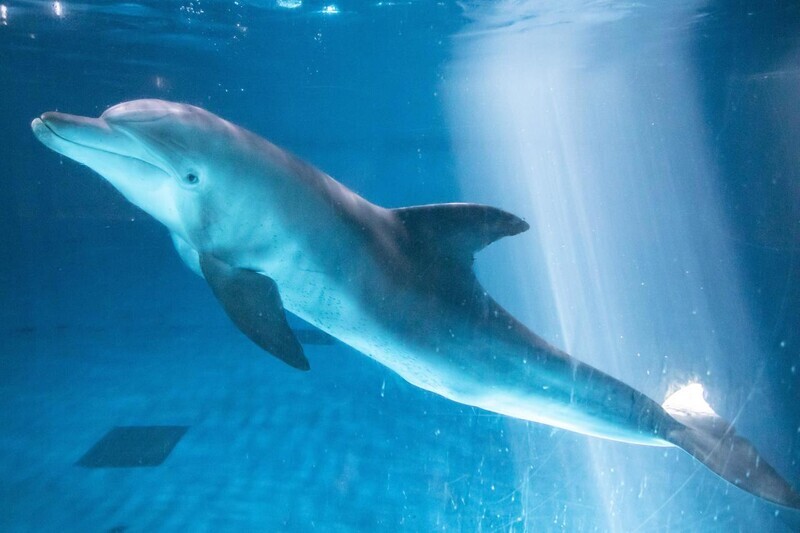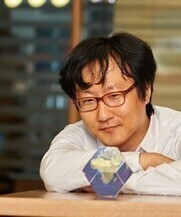hankyoreh
Links to other country sites 다른 나라 사이트 링크
[Column] The fate of Bibong the Korean dolphin, released as a means to an end


South Korea’s Indo-Pacific bottlenose dolphin Bibong has now been missing for over three months. Bibong was originally illegally poached off the coast of Biyang Island in Jeju in 2005 and was recently released back into the wild after being a performing dolphin at Jungmun Marine Park Pacific Land for over 15 years.
Indo-Pacific bottlenose dolphins usually live within 1 to 2 kilometers of the coast. This means that if Bibong’s whereabouts have still not been discovered, we should brace ourselves for the worst.
On Aug. 3 last year, Minister of Oceans and Fisheries Cho Seung-hwan himself announced that Bibong would be released into the sea off of Jeju Island.
With the subject of whales gaining widespread popularity through the drama Extraordinary Attorney Woo, the release of Bibong attracted major media attention. Two months later, Koreans happily sent off Bibong into the wild.
There were some concerns, however, when Bibong was released. Animal People, the Hankyoreh’s publication specializing in animals, and various animal organizations pointed out that there is no clear recovery plan in case of failure when releasing animals back into the wild. Two cases in point are those of Geumdeung and Daepo, dolphins who lived in aquariums for 15-20 years and who ended up being unsuccessfully released back into the wild.
Nevertheless, the release consultative group led by the Ministry of Oceans and Fisheries guaranteed the success of their plans. They made big noise when sending Bibong into the wild, but now no one is willing to come forward to take responsibility for Bibong’s fate.
This reminds me of the mink liberation incident in England in 1998. Back then, a radical animal rights group called the Animal Liberation Front (ALF) entered a mink farm near New Forest National Park and set 6,000 mink free. The ALF is also the organization that rescued the genetically modified super pig in Bong Joon-ho’s film “Okja.”
The 1998 mink incident sparked controversy in the UK. Scholars criticized the move, saying most of the mink would end up starving to death since they were being released to places that were completely foreign to them. Most animal groups turned their backs against the ALF while Respect for Animals’ Mark Glover said the move was a “disaster for the anti-fur movement and a disaster for the minks.”
In response, the ALF stated that, although they knew the mink would die, “before they die, they can at least taste a little bit of freedom.” A month and a half before this, the Labor government had announced the abolition of fur farms, citing overwhelming public opinion against fur.
It would have been nice if we could have asked Bibong’s opinion and then decided on his release into the wild. But as we know, that’s not possible. As such, we must be as cautious as possible when taking responsibility for an animal's fate.
This is because Bibong, just like the mink, would have to experience his world being turned upside down.
When determining the fate of an animal, decisions should be made taking into consideration science, philosophy and experience. So how did things turn out this time around?
First of all, as science tells us, Bibong was unfit for release. The longer the time spent in captivity in an aquarium, the higher the chance of failure when releasing dolphins into the wild.
When they’re young, dolphins have to remember the geography of the Jeju waters, the direction of the ocean current, and how to recognize geographical features through sound waves. Moreover, dolphins are social animals, and the scientific standard is to release two or more at a time.
Second, when it comes to philosophy, only ideologies centered around the liberation of animals took precedence. Just as we can’t sacrifice anyone for the sake of democracy, when releasing animals into the wild, it is necessary to seriously consider how their quality of life will change while also considering the overall ripple effect of their release.
Third, although we had the experiences of Geumdeung and Daepo, we didn’t learn anything from these cases. Sadly, both of these dolphins who were released in 2017 are believed to have died. Despite this, however, the Ministry of Oceans and Fisheries, which was responsible for this 2017 release operation, did not even publish a white paper and also didn’t hesitate to release Bibong under similar conditions.
So who will be the ultimate winner in this situation? Let’s go back a few years.
Pacific Land, which was established in 1986 and was the aquarium home to Bibong, Geumdeung and Daepo, represents the real living history of Korea’s dolphin aquariums.
As the dolphin liberation movement led by the case of Jedol the dolphin spread and the dolphin show industry declined in the 2010s, Hoban Group, the 30th largest financial corporation, acquired Pacific Land for 80 billion won in 2017.
Hoban Group acquired the aquarium to build a large-scale resort with great ocean views. So what was it that Hoban needed? To have the dolphins disappear quickly.
However, as an endangered species, it's tricky to bring dolphins in or take them out of the country. In May of last year, Pacific Resom, a subsidiary of the Hoban Group, secretly sent two bottlenose dolphins originally from Japan to Geoje Sea World without reporting it to the Ministry of Environment.
The last remaining dolphin at the aquarium was Bibong. The Ministry of Oceans and Fisheries, the Jeju municipal government, and civil society groups suddenly all agreed with Hoban Group’s plan to release Bibong into the wild.
Now all that’s left for Hoban is to demolish the aquarium and build their resort. Meanwhile, there is no news at all about Bibong’s release back into the ocean.
Please direct questions or comments to [english@hani.co.kr]

Editorial・opinion
![[Guest essay] The real reason Korea’s new right wants to dub Rhee a founding father [Guest essay] The real reason Korea’s new right wants to dub Rhee a founding father](https://flexible.img.hani.co.kr/flexible/normal/500/300/imgdb/original/2024/0423/8317138574257878.jpg) [Guest essay] The real reason Korea’s new right wants to dub Rhee a founding father
[Guest essay] The real reason Korea’s new right wants to dub Rhee a founding father![[Column] ‘Choson’: Is it time we start referring to N. Korea in its own terms? [Column] ‘Choson’: Is it time we start referring to N. Korea in its own terms?](https://flexible.img.hani.co.kr/flexible/normal/500/300/imgdb/original/2024/0423/3617138579390322.jpg) [Column] ‘Choson’: Is it time we start referring to N. Korea in its own terms?
[Column] ‘Choson’: Is it time we start referring to N. Korea in its own terms?- [Editorial] Japan’s rewriting of history with Korea has gone too far
- [Column] The president’s questionable capacity for dialogue
- [Column] Are chaebol firms just pizza pies for families to divvy up as they please?
- [Column] Has Korea, too, crossed the Rubicon on China?
- [Correspondent’s column] In Japan’s alliance with US, echoes of its past alliances with UK
- [Editorial] Does Yoon think the Korean public is wrong?
- [Editorial] As it bolsters its alliance with US, Japan must be accountable for past
- [Guest essay] Amending the Constitution is Yoon’s key to leaving office in public’s good graces
Most viewed articles
- 1[Column] ‘Choson’: Is it time we start referring to N. Korea in its own terms?
- 2Why Korea shouldn’t welcome Japan’s newly beefed up defense cooperation with US
- 3[Guest essay] The real reason Korea’s new right wants to dub Rhee a founding father
- 4Samsung barricades office as unionized workers strike for better conditions
- 5Senior doctors cut hours, prepare to resign as government refuses to scrap medical reform plan
- 6[Editorial] Japan’s rewriting of history with Korea has gone too far
- 7[Column] The clock is ticking for Korea’s first lady
- 8Opposition calls Yoon’s chief of staff appointment a ‘slap in the face’
- 9New AI-based translation tools make their way into everyday life in Korea
- 10Korean government’s compromise plan for medical reform swiftly rejected by doctors